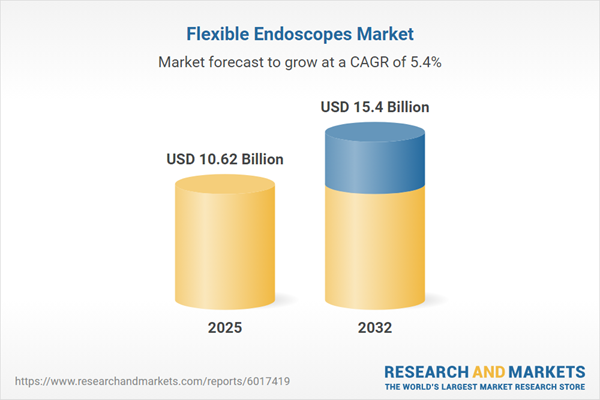Speak directly to the analyst to clarify any post sales queries you may have.
The flexible endoscopes market is experiencing robust growth as healthcare providers worldwide prioritize advanced visualization technologies to achieve greater diagnostic accuracy and procedural efficiency. Senior executives are tasked with navigating complex procurement, supply chain, and regulatory environments to stay ahead in this fast-evolving segment.
Market Snapshot: Flexible Endoscopes Market Overview
The flexible endoscopes market grew from USD 10.10 billion in 2024 to USD 10.62 billion in 2025. It is expected to continue growing at a CAGR of 5.40%, reaching USD 15.40 billion by 2032. This expansion reflects sustained investment in minimally invasive procedures and rising demand for precision-driven diagnostic and therapeutic capabilities within healthcare delivery ecosystems.
Scope & Segmentation
- Endoscope Types: Bronchoscopes for airway diagnostics, colonoscopes for colorectal screening, duodenoscopes, enteroscopes, and gastroscopes supporting a wide range of applications.
- Product Types: Disposable models streamline infection control and reusable formats backed by advanced reprocessing protocols.
- Components: Cameras equipped with high-resolution sensors, display systems such as LCD and OLED screens, and light sources utilizing LED technology.
- Distribution Channels: Offline networks of medical device distributors and hospitals, complemented by online procurement platforms for faster replenishment.
- Applications: Gastroenterology, gynecology (including hysteroscopy and laparoscopy), neurology, pulmonology (bronchoscopy, thoracoscopy) and urology (cystoscopy, ureteroscopy).
- End Users: Diagnostic centers, hospitals, and clinics seeking both broad and specialized imaging solutions.
- Geographic Regions: Americas (United States, Canada, Mexico, Latin America), Europe, Middle East & Africa (including Western Europe, Middle Eastern and African growth markets), Asia-Pacific (China, India, Japan, Australia, South Korea, and others).
- Leading Companies: Industry leaders include Ambu A/S, B. Braun SE, Becton, Dickinson, and Company, Boston Scientific Corporation, Fujifilm Holdings Corporation, Olympus Corporation, Stryker Corporation, and over a dozen additional established and emerging players.
Key Takeaways for Decision-Makers
- Flexible endoscopes feature high-definition optics and articulated channels, facilitating minimally invasive interventions across diverse clinical fields.
- Advancements in disinfection protocols and the rise of single-use formats respond to stringent infection control standards and help reduce cross-contamination risk.
- Artificial intelligence and machine learning capabilities are being integrated into imaging systems to support automated lesion detection and enhance diagnostic reliability.
- Collaborative supplier partnerships and cloud-based analytics are optimizing supply chains, supporting predictive maintenance, and benchmarking device performance.
- Regionally tailored regulatory compliance and strategic localization of supply and assembly are enabling providers to mitigate procurement risks and accelerate market entry.
Tariff Impact: Navigating United States 2025 Import Tariffs
The 2025 introduction of import tariffs in the United States is compelling the industry to re-evaluate sourcing, cost management, and manufacturing strategy for flexible endoscopes. Suppliers are intensifying regional production and assembly to minimize tariff exposure, while healthcare providers engage in volume-based contracting and group purchasing to offset increased importation costs. These regulations are set to shape future trade patterns, encourage material innovation, and promote closer-to-patient assembly models for supply resilience.
Research Methodology & Data Sources
This market evaluation combines primary interviews with clinicians, hospital procurement directors, and manufacturers alongside in-depth secondary data reviews of industry reports, regulatory filings, and published studies. Data triangulation and expert workshops ensure that insights are validated and reflect a comprehensive industry perspective.
Why This Report Matters
- Enable strategic investment by mapping emerging technology trends and detailed segmentation opportunity.
- Support operational resilience and competitive positioning through in-depth analysis of regulatory and tariff-driven market dynamics.
- Empower supplier and healthcare leadership with evidence-based recommendations for product development and risk management.
Conclusion
Flexible endoscopy is rapidly evolving, with innovation and regional strategy shaping market leadership. Use this report to inform procurement, partnership, and technology adoption decisions in a dynamic healthcare landscape.
Additional Product Information:
- Purchase of this report includes 1 year online access with quarterly updates.
- This report can be updated on request. Please contact our Customer Experience team using the Ask a Question widget on our website.
Table of Contents
3. Executive Summary
4. Market Overview
7. Cumulative Impact of Artificial Intelligence 2025
Companies Mentioned
The companies profiled in this Flexible Endoscopes market report include:- Ambu A/S
- B. Braun SE
- Becton, Dickinson, and Company
- Boston Scientific Corporation
- Cantel Medical Corporation
- Conmed Corporation
- Cook Medical Inc.
- EndoMed Systems GmbH
- Firefly Global
- Fujifilm Holdings Corporation
- H.W.Andersen Products Ltd.
- Hoya Corporation
- Intuitive Surgical, Inc.
- Karl Storz SE & Co. KG
- Machida Endoscope Co. Ltd
- Olympus Corporation
- Optomic España S.A.
- Richard Wolf GmbH
- Schölly Fiberoptic GmbH
- Shaili Endoscopy
- Shenyang Shenda Endoscope Co. Ltd
- SonoScape Medical Corp.
- Steris Corporation
- Stryker Corporation
- Teleflex Incorporated
- XION GmbH
Table Information
| Report Attribute | Details |
|---|---|
| No. of Pages | 192 |
| Published | November 2025 |
| Forecast Period | 2025 - 2032 |
| Estimated Market Value ( USD | $ 10.62 Billion |
| Forecasted Market Value ( USD | $ 15.4 Billion |
| Compound Annual Growth Rate | 5.4% |
| Regions Covered | Global |
| No. of Companies Mentioned | 27 |









